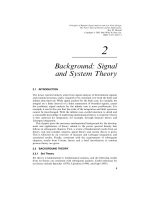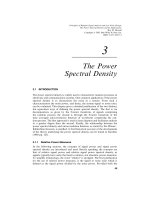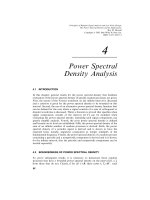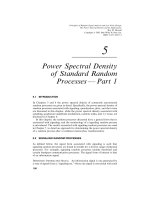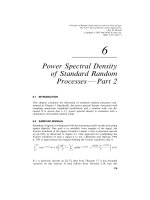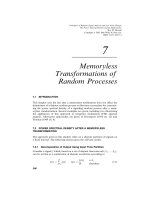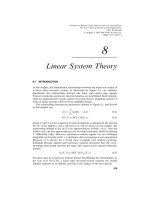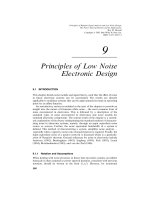Tài liệu Nguyên tắc phân tích tín hiệu ngẫu nhiên và thiết kế tiếng ồn thấp P4 pptx
Bạn đang xem bản rút gọn của tài liệu. Xem và tải ngay bản đầy đủ của tài liệu tại đây (349.27 KB, 46 trang )
4
Power Spectral
Density Analysis
4.1 INTRODUCTION
In this chapter, general results for the power spectral density that facilitate
evaluation of the power spectral density of specific random processes are given.
First, the nature of the Fourier transform on the infinite interval is discussed
and a criterion is given for the power spectral density to be bounded on this
interval. Second, the use of an alternative power spectral density function that
can be defined for the case where a signal consists of a sum of orthogonal or
disjoint waveforms is discussed. Third, a theorem is proved that specifies when
signal components outside of the interval [0, T ] can be included when
evaluating the power spectral density. Including such signal components can
greatly simplify analysis. Fourth, the cross power spectral density is defined
and bounds on its level are established. Fifth, the power spectral density of the
sum of an infinite number of random processes is derived. Sixth, the power
spectral density of a periodic signal is derived and is shown to have the
expected form, namely, impulsive component at integer multiples of the
fundamental frequency. Finally, the power spectral density of a random process
containing a periodic and a nonperiodic component is derived and it is shown,
for the infinite interval, that the periodic and nonperiodic components can be
treated separately.
4.2 BOUNDEDNESS OF POWER SPECTRAL DENSITY
To prove subsequent results, it is necessary to demarcate those random
processes that have a bounded power spectral density on the interval [0, -],
from those that do not. Clearly, if for all f + R, there exists k, T
M
+ R>, such
92
Principles of Random Signal Analysis and Low Noise Design:
The Power Spectral Density and Its Applications.
Roy M. Howard
Copyright
¶
2002 John Wiley & Sons, Inc.
ISBN: 0-471-22617-3
that T 9 T
M
"X(T, f )":k(T (4.1)
then
lim
2
G
6
(T, f ) : lim
2
"X(T, f )"
T
: k f + R (4.2)
Note, any signal that is periodic or contains a periodic component (including
the degenerate case of a nonzero mean) will not satisfy this criterion. To see
this, consider a periodic signal x, with period T
N
: 1/f
N
that satisfies appropri-
ate conditions (Theorem 2.26) such that it can be written, using an exponential
Fourier series, as
x(t) :
G\
c
G
eHLGD
N
R (4.3)
whereupon, for f equal to the qth harmonic, it follows that
X(T, qf
N
) : c
O
T ;
2
G\
G$O
c
G
eHLG\OD
N
R dt (4.4)
Clearly, when c
O
" 0, it is the case that both "X(T, qf
N
)" and G(T, qf
N
) increase
in proportion to T. Thus, for a periodic signal, or the degenerate case of a signal
with nonzero mean, the power spectral density is not bounded at specific
frequencies. The unboundedness is restricted to a set of zero measure for a
finite power random process.
4.2.1 Alternative Formulation for Boundedness
The following theorem gives an alternative criterion for the boundedness of
G
6
(T, f )asT ; -.
T 4.1. B P S D Consider the se-
quence of functions X
, ..., X
,
produced by a disjoint partition of the interval
[0, T ] and defined according to
X
G
( f ) :
G2
G\2
x(t)e\HLDR dt i+ +1, ..., N, (4.5)
BOUNDEDNESS OF POWER SPECTRAL DENSITY
93
such that
X(T, f ) :
,
G
X
G
( f ) (4.6)
Here, N : T/T
M
for some fixed T
M
and T is such that NT : T. If, for all
f + R there exists a T
M
9 0 such that T T
M
the mean of X
( f ), ..., X
,
( f )
decays according to (N as T and N increase without bound, that is, there exists
an integer N
M
9 0 and a constant k
V
+ R>, such that N 9 N
M
1
N
,
G
X
G
( f )
:
k
V
(N
f + R (4.7)
then both
sup
lim
2
"X(T, f )"
(T
: f + R
and sup
lim
2
G(T, f ): f + R
are finite.
Proof. This result follows by simply noting that
1
N
,
G
X
G
( f )
:
k
V
(N
$
T
T
"X(T, f )":
k
V
(T
(T
$ "X(T, f )":
k
V
(T
(T
(4.8)
and as N ; - it is the case that T ; T
M
.
4.2.1.1 Notes This formulation is best understood by considering N out-
comes x
, ..., x
,
of N independent and identically distributed random vari-
ables with zero mean and variance . For N sufficiently large, and with a
probability of 0.95, independence guarantees, as per the central limit theorem
(Grimmett, 1992 p. 175; Larson, 1986 p. 322), that
91.96(N :
,
G
x
G
: 1.96(N $
1
N
,
G
x
G
:
1.96
(N
(4.9)
Hence, if there exists a time T
M
, such that for all longer time intervals it is the
case that X
( f ), ..., X
,
( f ) are independent samples, consistent with outcomes
from N independent and identically distributed random variables, then the
power spectral density of that process is guaranteed to be bounded. Such a
result is consistent with the ‘‘correlation time’’ of the signal being less than T
M
.
94
POWER SPECTRAL DENSITY ANALYSIS
4.2.2 Definition — Bounded Power Spectral Density
D:B P S D A random process X is said
to have a bounded power spectral density if the above criteria hold, that is, if
k
V
+ R>, such that
sup+G
6
(T, f ): T + R>, f + R,:k
V
(4.10)
In subsequent analysis, it will be assumed that random processes have a
bounded power spectral density, or at most, have a bounded component plus
an unbounded component due to periodic signal(s).
4.3 POWER SPECTRAL DENSITY VIA SIGNAL DECOMPOSITION
Consider an interval [0, T ] on which a signal x can be written as the sum of
N disjoint, or orthogonal waveforms according to
x(t) :
,
G
x
G
(t) t+ [0, T ] (4.11)
The average power on the interval [0, T ]is
P
:
1
T
2
"x(t)" dt :
1
T
2
,
G
"x
G
(t)" dt (4.12)
From Parseval’s relationship it follows that
P
:
\
"X(T, f )"
T
df :
\
,
G
"X
G
(T, f )"
T
df (4.13)
which suggests, for the signal being considered, two alternative definitions for
the power spectral density, respectively, denoted G
6
and G
6"
:
G
6
(T, f ) :
"X(T, f )"
T
G
6"
(T, f ) :
,
G
"X
G
(T, f )"
T
(4.14)
By definition, G
6
is the correct power spectral density. While G
6"
is a valid
power spectral density, as far as the average power is concerned, it may be the
case that G
6
(T, f ) " G
6"
(T, f ) almost everywhere, including the points if
M
,
i + Z> where f
M
: 1/T. If this is the case, then G
6"
(T, f ) does not have the
interpretation required for a power spectral density, as per Theorem 3.2,
namely, that the area of each pair of rectangles of width f
M
, centered at 9if
M
and if
M
, and with respective heights G
6"
(T, 9if
M
) and G
6"
(T, if
M
), is equal to the
power in the sinusoidal components with a frequency if
M
.
POWER SPECTRAL DENSITY VIA SIGNAL DECOMPOSITION
95
x(t)
p(t)
t
1
1234
t
2
1
1
Figure 4.1 Graphs for the signal x and the pulse function p.
4.3.1 Example
Consider the waveform x and the pulse function p, as shown in Figure 4.1. The
signal x can be written in terms of the pulse waveform p according to
x(t) : p
t
2
; p(t 9 3) (4.15)
and it follows that the power spectral density of this signal, evaluated on the
interval [0, 4], is
G
6
(4, f ) :
"X(4, f )"
T
:
"2P(2f ) ; P( f )e\HLD"
T
(4.16)
:
4"P(2f )";"P( f )";4 Re[P(2f )P*( f )e HLD]
T
The first line in this equation follows from the relationships (McGillem, 1991
p. 146):
(t 9 t
B
) V ( f )e\HLDR
B
v(at)
V ( f/a)
"a"
(4.17)
Now, x can be decomposed, in terms of disjoint signals defined by delayed
versions of p, according to
x(t) :
G
x
G
(t) : p(t) ; p(t 9 1) ; p(t 9 3) (4.18)
and the alternative power spectral density function G
6"
can be defined as
G
6"
(4, f ) :
G
"X
G
(4, f )"
T
:
3"P( f )"
T
(4.19)
The power spectral densities G
6
and G
6"
are plotted in Figure 4.2 using the
result that P( f ) : sinc( f )e\HLD. Clearly, for this case G
6
(T, f ) " G
6"
(T, f )
almost everywhere. In particular, when T : 1/f
M
: 4 it is the case that
96
POWER SPECTRAL DENSITY ANALYSIS
0.25 0.5 0.75 1 1.25
0.5
1
1.5
2
2.5
PSD
f
o
2f
o
3f
o
Frequency (Hz)
G
X
(T, f)
G
XD
(T, f)
Figure 4.2 Graphs of true and alternative power spectral density functions.
P(2f )"
DD
M
: 0, and
G
6
(T,2f
M
) :
"P(2f
M
)"
T
:
sinc(0.5)
4
: 0.1013
(4.20)
G
6"
(T,2f
M
) :
3"P(2f
M
)"
T
:
3 sinc(0.5)
4
: 0.3039
Hence, for f : 2f
M
, the alternative power spectral density, G
6"
, does not
predict the power in sinusoids with a frequency of 2f
M
.
4.3.2 Explanation
If the signal x can be written as a summation of N signals according to Eq.
(4.11), then the power spectral density can be written as
G
6
(T, f ) :
"X(T, f )"
T
:
1
T
,
G
"X
G
(T, f )";
1
T
,
G
,
H
H$G
X
G
(T, f )X
*
H
(T, f )
(4.21)
: G
6"
(T, f ) ;
1
T
,
G
,
H
H$G
X
G
(T, f )X
*
H
(T, f )
Clearly, the cross product terms constitute the difference between the two
power spectral densities. Since disjointness or orthogonality is a sufficient
condition for the integral of each term in the double summation in this
POWER SPECTRAL DENSITY VIA SIGNAL DECOMPOSITION
97
p(t)
p(t − D) p(t − 2D) p(t − 3D) p(t − 4D)
D
t
T
Include
componen
t
2D 3D
Figure 4.3 Pulse waveform p and waveforms comprising the signal x.
equation to be zero, it follows, in terms of the average power, that there is no
difference between the two power spectral densities. However, when interpreted
as the power in the sinusoidal components at a specific frequency, the
alternative power spectral density G
6"
, in general, is not correct.
4.4 SIMPLIFYING EVALUATION OF POWER SPECTRAL DENSITY
Consider the countable case and a random process X, defined by an ensemble
E
6
: +x
G
: i+ Z>, where P[x
G
] : p
G
. The power spectral density requires the
evaluation of the Fourier transform of each waveform in the ensemble over the
interval [0, T ], that is,
G
6
(T, f ) :
G
p
G
"X
G
(T, f )"
T
(4.22)
However, truncation of the signal through use of the interval [0, T ] often
complicates analysis, while inclusion of some component of the signal outside
of this interval can simplify analysis, as the following example illustrates.
4.4.1 Example
Consider the evaluation of the power spectral density on the interval [0, T ], of
a signal that consists of a summation of pulse waveforms, that is,
x(t) :
G
p(t 9 iD) (4.23)
where p has the form shown in Figure 4.3. The waveforms comprising the signal
x are also shown in this figure, assuming, for illustrative purposes, that T : 4D.
The Fourier transform of x on the interval [0, T ], for T : 4D, is given by
X(T, f ) : P( f ) ; P( f )e\HLD" ; P( f )e\HLD" ; P
( f ) (4.24)
where P is the Fourier transform of p, and P
is the Fourier transform of
98
POWER SPECTRAL DENSITY ANALYSIS
p(t 9 3D) evaluated on the interval [0, T ]. Clearly, analysis can be simplified
if the component of p(t 9 3D) outside of [0, T ], as shown in Figure 4.3, can be
included, whereupon the approximation
X
(T ; D, f ) : P( f ) ; P( f )e\HLD" ; P( f )e\HLD" ; P( f )e\HLD" (4.25)
is obtained. Such a Fourier transform is consistent with the approximate signal
x
being defined as equal to the x on the interval [0, T ], but including the
component of p(t 9 3D) outside this interval, that is,
x
(t) :
G
p(t 9 iD) t+ [0, T ; D)
0 elsewhere
(4.26)
The power spectral density of x
over the interval [0, T ; D], but normalized
by T rather than the interval length T ; D, can be defined as
G
6
(T ; D, f ) :
"X
(T ; D, f )"
T
(4.27)
and ideally, is such that G
6
(T ; D, f ) G
6
(T, f ) for all frequencies.
The inclusion of the contribution of a signal component outside the interval
[0, T ], when evaluating the power spectral density, is justified if the contribu-
tion of the energy in this component to the average signal power is negligible.
This result is formally stated by Theorem 4.2 in the following section.
4.4.2 Approximate Power Spectral Density
Define the interval, or in general the set of numbers, that simplifies analysis of
the power spectral density as F. This set could, in the general case, consist of
part of the interval [0, T ], and part of the remainder of the real line. It is
convenient to partition F into two disjoint sets, that is,
F : F
'
6 F
-
where F
'
3 [0, T ] F
-
3 [0, T ]! (4.28)
In subsequent analysis, it is convenient to define a new set F
0
according to
F
0
: [0, T ] 5 F
!
'
s.t. [0, T ] : F
'
6 F
0
(4.29)
The subscripts I, O, and R, respectively, stand for ‘‘inner,’’ ‘‘outer,’’ and
‘‘residual.’’ The sets F
'
, F
-
, and F
0
are graphically shown in Figure 4.4. The
measure of the sets F
'
, F
-
, and F
0
, respectively, are denoted M
'
, M
-
, and M
0
,
and the respective powers of the ith signal in these sets are denoted P
G
(F
'
),
P
G
(F
-
), and P
G
(F
0
).
SIMPLIFYING EVALUATION OF POWER SPECTRAL DENSITY
99
0
T
F
I
F
R
F
O
F
Figure 4.4 Definition of the sets F
I
,F
O
, and F
R
.
Consider a random process X with ensemble E
6
: +x
G
: i+ Z>,. Define the
random process X
with ensemble E
6
, consisting of waveforms that individ-
ually are identical on [0, T ] to a corresponding waveform from X, but may
differ from the corresponding waveform outside this interval. Thus,
E
6
:
x
G
: x
G
(t) :
x
G
(t)
STFA
t+ [0, T ], x
G
+ E
6
t, [0, T ]
i + Z>
(4.30)
Here, STFA means ‘‘specified to facilitate analysis,’’ that is, outside [0, T ], x
G
is specified in a manner that best facilitates analysis. The power spectral density
of X
, evaluated over the set F, is denoted G
6
and is defined according to
G
6
(F, f ) :
G
p
G
"X
G
(F, f )"
T
X
G
(F, f ) :
$
x
G
(t)e\HLDR dt (4.31)
Note, the interval length used in the definition for G
6
is T and not the
measure of the set F. This is because G
6
is an approximation to the true
power spectral density G
6
on the interval [0, T ]. The following theorem
quantifies how well the power spectral density of X
approximates the power
spectral density of X.
T 4.2. A P S D T he integrated
relative difference
0
, between G
6
(F, f ) and G
6
(T, f ) has the upper bound given
by the following two equivalent expressions:
0
:
\
"G
6
(T, f ) 9 G
6
(F, f )" df
\
G
6
(T, f ) df
-
M
0
T
P
(F
0
)
P
(T )
;
M
-
T
P
(F
-
)
P
(T )
;2
M
'
T
P
(F
'
)
P
(T )
M
0
T
P
(F
0
)
P
(T )
;2
M
'
T
P
(F
'
)
P
(T )
M
-
T
P
(F
-
)
P
(T )
(4.32)
100
POWER SPECTRAL DENSITY ANALYSIS
0
-
E
(F
0
)
E
(T )
;
E
(F
-
)
E
(T )
; 2
E
(F
'
)
E
(T )
E
(F
0
)
E
(T )
; 2
E
(F
'
)
E
(T )
E
(F
-
)
E
(T )
(4.33)
where P
(T ) is the average power of X on [0, T ], P
(F
0
) and P
(F
'
), respectively,
are the average power of X and X
on the sets F
0
and F
'
, P
(F
-
) is the average
power of X
on the set F
-
, and the symbol E
denotes the average energy
associated with the average power P
. T hese powers and energies are defined
according to
P
(F
0
) :
\
G
6
(F
0
, f ) df :
\
G
6
(F
0
, f ) df :
E
(F
0
)
M
0
(4.34)
P
(F
'
) :
\
G
6
(F
'
, f ) df :
\
G
6
(F
'
, f ) df :
E
(F
'
)
M
'
(4.35)
P
(F
-
) :
\
G
6
(F
-
, f ) df :
E
(F
-
)
M
-
(4.36)
Here, and for the countable case:
G
6
(F
0
, f ) :
G
p
G
"X
G
(F
0
, f )"
M
0
:
G
p
G
"X
G
(F
0
, f )"
M
0
: G
6
(F
0
, f ) (4.37)
G
6
(F
'
, f ) :
G
p
G
"X
G
(F
'
, f )"
M
'
:
G
p
G
"X
G
(F
'
, f )"
M
'
: G
6
(F
'
, f ) (4.38)
G
6
(F
-
, f ) :
G
p
G
"X
G
(F
-
, f )"
M
-
(4.39)
Proof. The proof for the countable case is given in Appendix 1. The proof
for the uncountable case follows in an analogous manner.
4.4.3 Specific Cases
As the measure of the set F
'
approaches T, it follows that P
(F
'
) approaches
P
(T ), and for this case, the upper bound on the integrated relative error can
be approximated according to
0
-
M
0
T
P
(F
0
)
P
(T )
;
M
-
T
P
(F
-
)
P
(T )
; 2
M
0
T
P
(F
0
)
P
(T )
; 2
M
-
T
P
(F
-
)
P
(T )
:
E
(F
0
)
E
(T )
;
E
(F
-
)
E
(T )
; 2
E
(F
0
)
E
(T )
; 2
E
(F
-
)
E
(T )
(4.40)
SIMPLIFYING EVALUATION OF POWER SPECTRAL DENSITY
101
Clearly, the measure of the sets F
-
and F
0
, relative to T, can be made
sufficiently small so a required relative integrated error bound is achieved.
A common case encountered in analysis is where F
-
: [T, -], F
'
: [0, T ]
consistent with F
0
: +,, and all signals of the random process X
in the
interval F
-
: [T, -] rapidly decay to zero. The following theorem details the
bounds on the integrated relative difference for this case.
T 4.3. A P S D —I
I If F : [0, NT ], with N 1, which implies F
0
: +,, F
'
: [0, T ],
and F
-
: [T, NT ] then the integrated relative difference,
0
, has the bound
0
-
(N 9 1)P
(F
-
)
P
(T )
; 2(N 9 1
P
(F
-
)
P
(T )
:
E
(F
-
)
E
(T )
; 2
E
(F
-
)
E
(T )
(4.41)
Proof. The proof of this theorem follows directly from Theorem 4.2.
As is clear from this theorem, when the ratio of the average energy in the
interval F
-
to the average energy in the interval [0, T ] approaches zero, the
integrated relative error also approaches zero and the approximate power
spectral density, G
6
, approaches the true power spectral density G
6
in a
‘‘mean’’ sense.
4.4.4 Example
Consider the case where
x(t) :
G
p(t 9 (i 9 1)D)0- t : 10D (4.42)
with p(t) : e\ROu(t) and : D : 1. The true power spectral density of x evalu-
ated on [0, 10], as well as the approximate power spectral density obtained
by including the tail of the exponential function in the interval [10, -], are
plotted in Figure 4.5. In Figure 4.6 the absolute difference between the true
and approximate power spectral densities, that is, "G
6
(10, f ) 9 G
6
(-, f )",is
shown. The integrated relative error between the true and approximate power
spectral densities, obtained by numerical integration, is 0.11, and is within the
bound predicted by Eq. (4.41) of 0.27.
4.5 THE CROSS POWER SPECTRAL DENSITY
In subsequent analysis the cross power spectral density between two random
processes is widely used. With the aim of defining the cross power spectral
density, consider two random processes X and Y, defined on the interval [0, T ]
102
POWER SPECTRAL DENSITY ANALYSIS
0.02 0.05 0.1 0.2 0.5 1 2
0.001
0.01
0.1
1
10
Frequency (Hz)
True
G
X
(10, f ), G
XA
(∞, f )
Figure 4.5 True (thick) and approximate (thin) power spectral densities.
G
X
(10, f )−G
XA
(∞, f )
0.02 0.05 0.1 0.2 0.5 1 2
0.001
0.005
0.01
0.05
0.1
0.5
1
Frequency (Hz)
Figure 4.6 The absolute difference between the true and approximate power spectral
densities shown in Figure 4.5.
by the respective ensembles E
6
and E
7
:
E
6
: +x: S
6
; [0, T ] ; C, (4.43)
E
7
: +y: S
7
; [0, T ] ; C, (4.44)
THE CROSS POWER SPECTRAL DENSITY
103
where S
6
, S
7
3 Z> for the countable case and S
6
, S
7
3 R for the uncountable
case. For the countable case, the ith signal, x(i, t) is written, for notational
convenience as x
G
(t). The probabilities associated with the waveforms in the
ensembles are as follows:
p
VG
: P[x(i, t)] : P[x
G
(t)] i+ Z> countable case
P[x(, t)"
HZ'
V
] :
'
V
f
6
() d I
V
3 R uncountable case
(4.45)
p
WH
: P[y( j, t)] : P[y
H
(t)] j + Z> countable case
P[y(, t)"
HZ'
W
] :
'
W
f
7
() d I
W
3 R uncountable case
(4.46)
where f
6
and f
7
are probability density functions defining signal probabilities
for the uncountable case.
D:C P S D The cross power spectral
density between two random processes X and Y is, by definition (Peebles, 1993
p. 210)
G
67
(T, f )
:
G
H
p
GH
X
G
(T, f )Y
*
H
(T, f )
T
countable case
1
T
\
\
X(
V
, T, f )Y*(
W
, T, f ) f
67
(
V
,
W
) d
V
d
W
uncountable case
(4.47)
where p
GH
is the joint probability of x
G
and y
H
, that is, p
GH
: P[x
G
, y
H
], f
67
is the
joint probability density function for x and y, that is,
P[x(
V
, t), y(
W
, t)"
H
V
Z'
V
H
W
Z'
W
] :
'
V
'
W
f
67
(
V
,
W
) d
V
d
W
(4.48)
and X and Y, respectively, are the Fourier transforms of x and y evaluated on
the interval [0, T ].
From the definition it readily follows that
G
76
(T, f ) : G
*
67
(T, f )(4.49)
104
POWER SPECTRAL DENSITY ANALYSIS
4.5.1 Cross Power Spectral Density — Dependent Case
Consider the case where X and Y are fully correlated, such that the following
dependencies hold for the countable and uncountable cases:
P[x
G
(t)] : P[y
G
(t)] : p
G
P[x
G
(t), y
H
(t)] : 0 i, j + Z>, i " j
P[x(, t)"
HZ'
] : P[y(, t)"
HZ'
] :
'
f () d (4.50)
P[x(
V
, t), y(
W
, t)"
H
V
Z'
V
H
W
Z'
W
] : 0 I
V
5 I
W
: `
For this case, the cross power spectral density, given by Eq. (4.47), simplifies to
G
67
(T, f ) :
G
p
G
X
G
(T, f )Y
*
G
(T, f )
T
countable case
1
T
\
X(, T, f )Y*(, T, f ) f () d uncountable case
(4.51)
4.5.2 Cross Power Spectral Density — Independent Case
For the case where X is independent of Y, the cross power spectral density,
given by Eq. (4.47), simplifies to
G
67
(T, f ) :
X
(T, f )Y
*(T, f )
T
(4.52)
where X
is the mean Fourier transform of the random process X defined, for
the countable case, according to
X
(T, f ) :
G
p
VG
X
G
(T, f ) :
G
p
VG
2
x
G
(t)e\HLDR dt :
2
V
(T, t)e\HLDR dt
(4.53)
Here,
V
is the mean signal of the random process X defined as
V
(T, t) :
G
p
VG
x
G
(t) t+ [0, T ] (4.54)
It has been assumed here that the order of summation and integration can be
interchanged in Eq. (4.53). Similar definitions hold for Y
* and
*
W
and for the
uncountable case.
THE CROSS POWER SPECTRAL DENSITY
105
Consistent with stationarity, if the random processes have constant means
on the interval [0, T ], that is,
V
(T, t) :
V
, the results:
2 sin(A) : 1 9 cos(2A)
2
e\HLDR dt :
1 9 e\HLD2
j2f
(4.55)
X
(T, f )Y
*(T, f )
V
*
W
:
1 9 e\HLD2
j2f
1 9 eHLD2
9j2f
:
2 9 2 cos(2 fT)
(2f )
(4.56)
:
1
(f )
sin(fT) : T sinc( fT)
imply the cross power spectral density can be written as
G
67
(T, f ) :
V
*
W
T sinc( fT) (4.57)
As T increases, Theorem 2.32 implies, for the infinite interval, that
G
67
( f ) :
V
*
W
( f ) (4.58)
4.5.3 Conditions for Cross Power Spectral Density to be Zero
A sufficient condition for the cross power spectral density G
67
(T, f ) to be zero
for T fixed and for all f + R, is for X to be independent of Y, and for either or
both of X and Y to have zero means on [0, T ].
4.5.4 Bounds on Cross Power Spectral Density
In analysis it is useful if the cross power spectral density between two random
processes can be neglected. The following theorem states several bounds.
T 4.4. B C P S D T he cross power
spectral density G
67
(T, f ) has the following bounds:
"Re[G
67
(T, f )] "-(G
6
(T, f )(G
7
(T, f ) (4.59)
"Re[G
67
(T, f )] "-
G
6
(T, f ) ; G
7
(T, f )
2
(4.60)
For the fully correlated case the bound is
"G
67
(T, f )"-(G
6
(T, f )(G
7
(T, f ) (4.61)
106
POWER SPECTRAL DENSITY ANALYSIS
For the fully correlated case, and with y(, t) : kx(, t) for all signals in the
ensemble, where k is a real constant, it is the case that
"G
67
(T, f )" : (G
6
(T, f )(G
7
(T, f )
If the random processes X and Y are independent then
"G
67
(T, f )"-(G
6
(T, f )(G
7
(T, f ) (4.62)
For the case where G
6
(T, f ) G
7
(T, f ) Eqs. (4.59), (4.61), and (4.62) imply that
"Re[G
67
(T, f )]" G
6
(T, f ) general case (4.63)
"G
67
(T, f )" G
6
(T, f )
independent case
fully correlated case
(4.64)
Proof. The proof for the countable case is given in Appendix 2. The proof
for the uncountable case follows in analogous manner.
4.6 POWER SPECTRAL DENSITY OF A SUM OF RANDOM
PROCESSES
Although the sum of two random processes is a subset of the general case of
the sum of N random processes, it is instructive to consider this case separately.
4.6.1 Power Spectral Density — Sum of Two Random Processes
Define the random process Z according to
Z : X ; Y (4.65)
where X and Y are defined by Eqs. (4.43)—(4.46). This random process is
defined for the countable case by the ensemble
E
8
: +z
GH
: [0, T ] ; C, z
GH
: x
G
; y
H
, i, j+ Z>, (4.66)
and the probability space P
8
:
P
8
:
p
GH
: p
GH
: P[z
GH
] : P[x
G
, y
H
],
G
H
p
GH
: 1
(4.67)
Analogous definitions follow for the uncountable case. For the special case of
X being independent of Y, it follows that p
GH
: p
VG
p
WH
. The following theorem
details the power spectral density of Z.
POWER SPECTRAL DENSITY OF A SUM OF RANDOM PROCESSES
107
T 4.5. P S D S T R
P T he power spectral density of the random process Z : X < Yis
given by
G
8
(T, f ) : G
6
(T, f ) ; G
7
(T, f ) < 2Re[G
67
(T, f )] (4.68)
where G
6
and G
7
, respectively, are the power spectral densities of X and Y, and
G
67
is the cross power spectral density between X and Y.
For the case where X is independent of Y the power spectral density of Z is
G
8
(T, f ) : G
6
(T, f ) ; G
7
(T, f ) <
2Re[X
(T, f )Y
*
(T, f )]
T
(4.69)
where X
and Y
* are mean Fourier transforms defined in a manner consistent with
Eq. (4.53).
For the case where X and Y are independent and stationary, such that their
respective means, denoted
V
and
W
, are constant on [0, T ], the power spectral
density is
G
8
(T, f ) : G
6
(T, f ) ; G
7
(T, f ) < 2Re[
V
*
W
]T sinc( fT) (4.70)
As T ; - the last term becomes impulsive to yield
G
8
( f ) : G
6
( f ) ; G
7
( f ) < 2Re[
V
*
W
]( f ) (4.71)
Proof. The proof of the first of these results is given in Appendix 3. The
subsequent results follow from the first result using definitions of the cross
power spectral density for the independent and stationary cases.
4.6.2 Power Spectral Density — Infinite Sum
Consider the infinite sequence of random processes X
, X
, ...with respective
ensembles E
6
, E
6
, . . . defined, on the interval [0, T ] and for the countable
case, according to
E
6
G
: +x
G
: Z>; [0, T ] ; C, i + Z>, (4.72)
where P[x
G
(
G
, t)] : p
G
(
G
). The random processes Z and Z
,
are defined by
weighted summations according to
Z
,
:
,
G
w
G
X
G
Z : lim
,
Z
,
:
G
w
G
X
G
(4.73)
108
POWER SPECTRAL DENSITY ANALYSIS
where w
G
is the weighting factor for the ith random process X
G
. The ensemble
associated with Z is
E
8
:
z: Z>;%;[0, T ] ; C, z(
, ..., t) :
G
w
G
x
G
(
G
, t)
(4.74)
The probability of a specific waveform z(
, ...,
,
, ..., t) in the ensemble
associated with the outcomes
,...,
,
, . . . is likely to be zero. To avoid the
complexities associated with an infinite number of signals, where each has a
vanishingly small probability, it is convenient to partition this ensemble as
follows:
E
8
:
8
D
G
%
8
D
,
E(
, ...,
,
) (4.75)
where E(
, ...,
,
) is the set of signals from E
8
whose first N waveforms in the
summation for z(
, ...,
,
, ..., t) are fixed and are x
(
, t), ..., x
,
(
,
, t), that
is,
E(
, ...,
,
) : +z(
, ...,
,
, ..., t):
,>
+ Z>,
,>
+ Z>,..., (4.76)
The probability of a waveform from E(
, ...,
,
) equals the probability of the
N outcomes
,...,
,
, denoted p(
, ...,
,
), and in general is nonzero.
Further, this probability equals the probability of the corresponding signal
from the ensemble of the random process Z
,
,
defined according to
E
8
,
:
z
,
: Z>;%;Z>;[0, T ];C, z
,
(
, ...,
,
, t) :
,
G
w
G
x
G
(
G
, t)
(4.77)
Here,
P[z
,
(
, ...,
,
, t)] : P[x
(
, t), ..., x
,
(
,
, t)] : p(
, ...,
,
) (4.78)
Thus, associated with each waveform in the ensemble for Z
,
is a set of
waveforms in the ensemble for Z. The probability of the waveform in Z
,
equals
the probability of the corresponding set of waveforms in Z.
If it is the case that the power spectral density of a specific waveform in Z
,
,
z
,
(
, ...,
,
, t), closely approximates the power spectral density of all of the
signals in the associated set E(
, ...,
,
)ofZ, that is, it is the case that
1
T
,
G
w
G
X
G
(
G
, T, f )
1
T
G
w
G
X
G
(
G
, T, f )
,>
+ Z>
,>
+ Z> ...
(4.79)
POWER SPECTRAL DENSITY OF A SUM OF RANDOM PROCESSES
109


